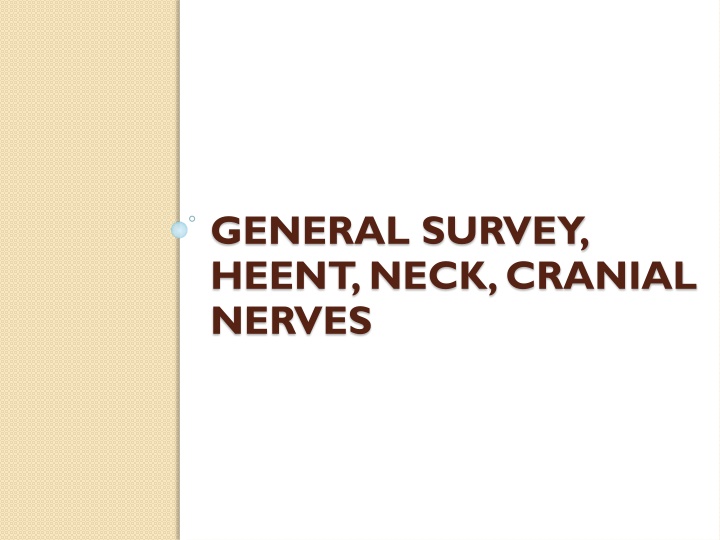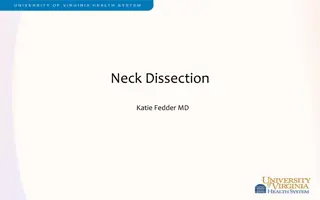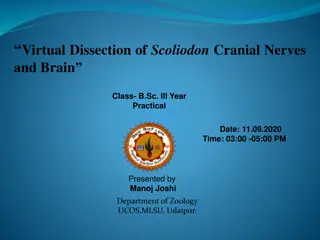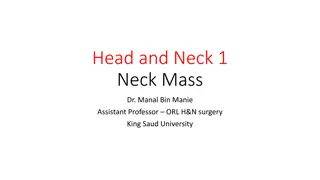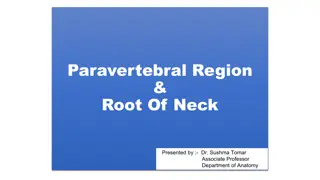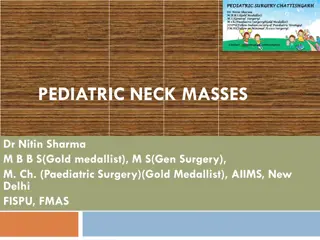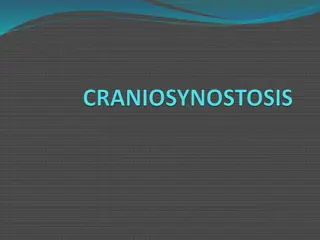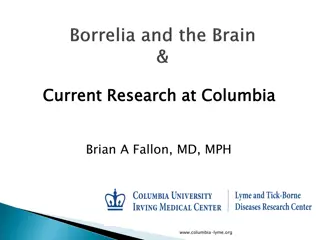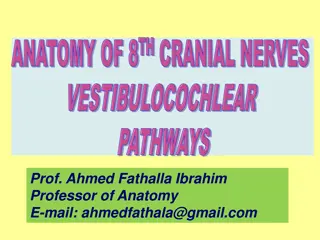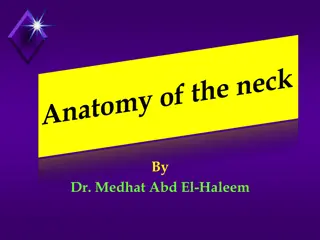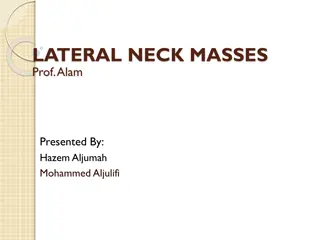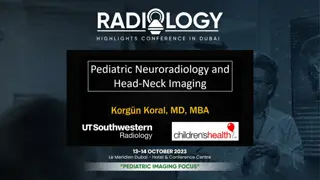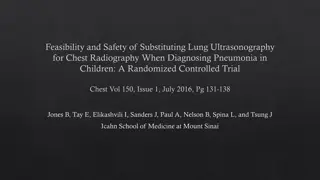Comprehensive Adult and Pediatric HEENT, Neck, and Cranial Nerves Examination Guide
This comprehensive guide outlines the components of a normal HEENT, neck, and cranial nerves examination for adults and pediatric patients, including identifying abnormal findings and conducting focused exams. It covers common or concerning symptoms related to the head, eyes, ears, nose, oropharynx, and neck. The guide also discusses focused examination techniques for adults, history questions to ask, and appropriate documentation methods for patient complaints.
Download Presentation

Please find below an Image/Link to download the presentation.
The content on the website is provided AS IS for your information and personal use only. It may not be sold, licensed, or shared on other websites without obtaining consent from the author.If you encounter any issues during the download, it is possible that the publisher has removed the file from their server.
You are allowed to download the files provided on this website for personal or commercial use, subject to the condition that they are used lawfully. All files are the property of their respective owners.
The content on the website is provided AS IS for your information and personal use only. It may not be sold, licensed, or shared on other websites without obtaining consent from the author.
E N D
Presentation Transcript
GENERAL SURVEY, HEENT, NECK, CRANIAL NERVES
Objectives HEENT, Neck and CNs: Demonstrate normal exam components for adult State normal exam components for pediatric patient Identify abnormal findings and tests Explain rationales for focused exam Document accurate findings
Common or Concerning Symptoms Head Eyes Headache, history of head injury Visual disturbances, spots (scotomas), flashing lights, use of corrective lenses, pain, redness, excessive tearing, double vision (diplopia) Hearing loss, ringing (tinnitus), vertigo, pain, discharge Drainage (rhinorrhea), congestion, sneezing, nose bleeds (epistaxis) Sore throat, gum bleeding, hoarseness, Swollen glands, goiter Ears Nose Oropharynx Neck
Focused Exam-Adults HEENT & Neck
AdultsExam Techniques How to examine .Head Ophthalmoscope exam Position to examine inner ear How to examine nares Mouth/tongue Oral Exam Cranial Nerves
Focused ExamAdult Case Chief complaint: Susan J. is a 33-year-old married factory worker who presents with a 6-day history of nasal congestion and rhinorrhea. How would you document Chief Complaint? Answer: In quotes, the patient s own words
History Questions What are the HPI components? OLDCART Based on chief complaint, what HEENT history needs to be asked? PMH, FH, SH What information must be asked for every episodic? 1.Medication Allergies 2. Medications What information must be asked for every childbearing woman? LMP
History Answers HPI: Onset, location, duration, associated/aggravating, relieving, treatments, characteristics/course PMH, FH, SH: Ask about history of allergies/asthma, family history of asthma, allergies, occupation triggers, smoking, habits All episodic visits: Medications, allergies All childbearing women: LMP
Adult Episodic Case: Susan History of Present Illness She was well until 6 days ago when she developed nasal congestion, a nonproductive cough, and clear rhinorrhea (onset, location, timing) Her nasal discharge became greenish yellow on the day of her visit, and she now asks for antibiotics for what she believes is a sinus infection (quality/perception). She complains of a constant generalized headache and pain in her nose and cheeks when she bends forward (severity/quality/aggravating/setting) .
Adult Episodic Case--Susan She admits to occasional chills and sweats but has not taken her temperature (associated symptoms) She denies pain in her teeth and has obtained minimal relief from over-the-counter decongestants (relieving/treatment). She denies using decongestant nose sprays. She says she has at least one or two sinus infections every year, and she cannot seem to get over them unless she takes an antibiotic.
Susan--History Past Medical History Susan has had two vaginal deliveries but no other hospitalizations. LMP: 2 weeks ago. She denies any history of serious illnesses or surgery. She has no history of asthma or hay fever Allergies: no history of drug, food, or seasonal allergies. Medications: oral contraceptive
Susan--history Family History There is no history of hay fever or asthma in the family. Father: HTN and elevated cholesterol. Mother: osteoarthritis. Her only sibling, an older brother, is alive and well. No grandparent history available. Social History Nonsmoker Alcohol 1-2 drinks/week (wine). Sexually active & monogamous Denies illicit drug use. Works on an electronics assembly line and helps her husband on the farm during the busy season.
Questions What ROS questions need to be asked? Cover HEENT, Neck, CV, Resp, GI What systems need to be examined for this episodic/focused exam? HEENT, Neck, CV, Resp, GI What system must be examined on every episodic case? Skin
Review of Symptoms-Susan General: As in HPI. No weight loss Head: Pain in frontal/maxillary sinus area, no dizziness, some lightheadedness Skin: no rashes, lumps or sores Eyes: no pain, redness, or excessive tearing, no vision changes Ears: no pain, no discharge, no change in hearing Nose: clear to green discharge noted, no nosebleeds, sinus infections 1-2 per year Throat: no bleeding gums, no sore throat, or hoarseness Oral: No painful teeth, no recent dental work Neck: no swollen glands, pain or stiffness of neck Respiratory: nonproductive cough, no shortness of breath or wheezing Cardiovascular: no chest pain, palpitations, or paroxysmal nocturnal dyspnea GI: no nausea, vomiting, constipation or diarrhea
Focused Exam--Susan General Survey Vital Signs Skin HEENT, Neck Lungs Cardiovascular Abdomen
Exam Findings: Documentation Normal: regular text Abnormal: bold text
Exam Findings: Documentation General Survey: Alert, WD, WN white woman with NAD, A & O x 3 VS: BP 110/70 mm Hg. HR 80, RR 20, T 98.8F Skin: no rash HEENT: Normocephalic, atraumatic; PERRLAC, disc margins sharp; fundi without hemorrhages or exudates; External ear canals patent; TMs with serous fluid bilaterally. Tenderness with palpation over maxillary sinuses. Nasal mucosa pink with clear discharge noted. Nasal patency decreased bilaterally. Oral mucosa; pharynx slight erythema, post-nasal drip, tonsils 2 +,without exudates. Neck: supple, without lymphadenopathy Respiratory: Thorax symmetric with good expansion; lungs resonant; breath sounds vesicular CV: rate regular, S1, S2 without S3 or S4; no murmurs, rubs or clicks GI: Bowel sounds present., abd soft, non tender to light & deep palpation. No masses noted.
Pediatric Considerations & Focused Exam for HEENT, Neck
How to Approach a Child for Exam What s different from examining an adult? Infant Toddler/preschool School age Adolescent Sequencing for HEENT and Neck depends on age of child
Head Exam: Key Points Head Circumference: Frontal to Occipital Fontanels/sutures: Anterior closes at 10-18 months, posterior by 2 months Symmetry & shape: Face & skull Facial expression: Sadness, signs of abuse, allergy, fatigue Abnormal facies: Diagnostic facies of common syndromes or illnesses Temporal bruits can be normal up to age 5 Hair: Patterns, loss, hygiene, pediculosis in school aged child
Eyes Exam: Key Points Always check red reflex Strabismus and Amblyopia (preschool child (cover/uncover test, corneal light) Tumbling E , Allen, Snellen charts for older children (visual acuity) PERRLA EOMs: tracking 6 fields of vision Fundoscopic exam of internal eye & retina
www.stjude.org/retinoblastoma For more information: http://s.stjude.org/multimedia/disease_summaries/retinoblastoma/spotlight_retinoblastoma_0602. swf
Geriatric --Eyes Normal Typical Variations
Pregnancy--Eyes spindle-shaped, vertical deposit of chocolate-brown coloured pigment in the cornea of the eye, created by flakes of pigment rubbed off the back of the iris.
Ears Exam: Key Points Examine last in younger children, hold young children in lap, head braced against parent s chest Hearing: language delay or frequent otitis media Otoscope exam: Pull auricle down & back for infants, toddlers, preschoolers Pull auricle up & back for school aged & adolescents Cerumen removal may be necessary Use pneumatic otoscopy Tuning fork: Weber & Rinne tests to differentiate conductive vs sensorineural
Conductive vs. Sensorineural Conductive hearing loss = external/middle ear dysfunction (noisy environment helps) Sensorineural hearing loss = inner ear (sounds like people are mumbling, noisy environment worse)
Special Ear Tests (See posted videos within module) Weber and Rinne are quick office screenings. If you or your patient has any concern with their hearing , you refer to audiologist for diagnostic testing. Pneumatic otoscopy is quite tricky. Don t get discouraged! Typanonometry- sensitive and specific for inner ear fluid, many office have these devices Have a low threshold for referring young children to audiologist- speech and language development is heavily impacted by even short periods of hearing impairment
Ears: Abnormal Tests Weber: Unilateral conductive hearing loss= sound heard in impaired ear Unilateral sensorineural hearing loss=sound is heard in good ear Rinne: Conductive: heard through bone as long or longer than air Sensorineural: sound is heard longer through air (normal pattern prevails)
http://www.kids-ent.com/website/pediatric_ent/ear_infections/index.htmlhttp://www.kids-ent.com/website/pediatric_ent/ear_infections/index.html
http://www.kids-ent.com/website/pediatric_ent/ear_infections/index.htmlhttp://www.kids-ent.com/website/pediatric_ent/ear_infections/index.html
Nose/ Mouth Exam: Pediatric Key Points Exam nose & mouth after ears (after crying from ear exam) Observe shape & structural deviations Nares: (check patency, mucous membranes, discharge, inferior turbinates, bleeding, foreign bodies) Septum: (check for deviation) Infants are obligate nose breathers Nasal flaring is associated with respiratory distress
Sinuses Exam: Key Points Palpate maxillary & frontal sinus areas for tenderness of sinusitis in older children Age of Development Maxillary cheek & upper teeth present @ birth Ethmoid medial & deep to eye present @ birth Frontal forehead & above eyebrow approximately 7 years Sphenoid deep behind eye in occiput adolescence
Mouth & Pharynx Exam: Key Points Inspect uvula for symmetrical movement Observe for quality of voice Observe infants for rooting and sucking reflexes Observe breath for halitosis Grade Tonsils Malampati Score (Aacute care and Anesthesia)
Oral Exam: Teeth, Gums, Buccal Mucosa Must use tongue blade or gloved finger to properly inspect mouth Inspect Teeth for caries, fractures, missing restorative elements Inspect Gums for sores, pustules, erosion around teeth Inspect Buccal mucosa for lesions Count teeth & inspect for caries, malocclusion and loose teeth. 20 deciduous teeth, begin eruption at 6 months & continue adding approximately 1/month 32 permanent teeth, erupt from 6 to 25 years
